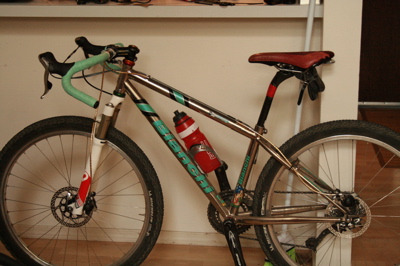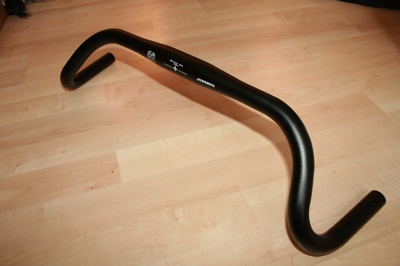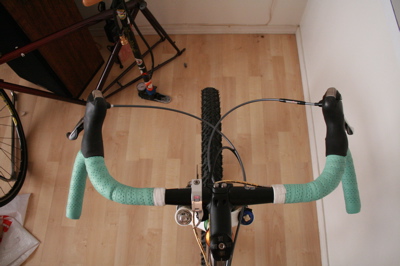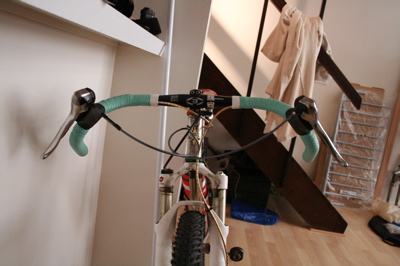
It’s time for an update on my dropbar mtb. I’ve been running it for several months with the FSA 2×9 crankset and Jtek derailleur adapter, and it works like a charm. My complaint about the FSA crankset is that the design doesn’t improve the chainline nor the q-factor that much over a standard three chainring mtb crank. The upcoming SRAM XX crank intrigues me, but my financial situation firmly puts that to rest. The Jtek Shiftmate adapter, which changes the cable pull of the 10sp STI to match the 9sp mtb cassette, has barely required any tuning. I’m quite pleased. I’m using a road triple STI to control the front derailluer, and it seems adequate. The left shifter is the most half-assed aspect of the bike, so I should thank my stars that it shifts as well as it does. But now both levers match, whereas before I had a right side STI and a standard brake lever with a bar end shifter on the left side. This lever symmetry allows the next evolution to my bike, this time at the handlebar.

As I briefly described in pt 3 , there were choices for a dropbar other than my FSA. The market for dropbar for offroad riding has seen a number of entries in the past few years. Certainly the concept of a wide, shallow drop harkens back to pre-WWII years when public roads were hardly as smooth as they are today, and some 1980s designs explored the concept during the early mtb boom. But there has been a recent, growing interest in offroad dropbars. Some say it’s the influence of 29ers.

Though I had considered bars such as the On-one Midge and Origin-8 Gary bar, I had to reject them because I couldn’t make my bike’s initially asymmetrical lever set-up work on such bars. I could get either the lever bodies in the same place, or I could get the levers to the same reach, but not both. One could argue that an offroad dropbar should only need to be usable from the drops, thus lever reach would be the overriding parameter. But I was unwilling to totally abdicate the hood position. So ended up choosing a more conventional road dropbar in the widest size available, 44cm c-c.

After I had gone with the symmetrical levers, I kept the road bar. They had worked great for cyclocross, so I wasn’t very motivated to change them until I did some technical offroad riding with some friends who had regular mtbs. The drops seemed too low and I couldn’t get the brakes to perform well enough to keep up with them on the tough sections. When I was on the drops, I had to awkwardly change my grip to brake effectively. When I rode from the hoods, hands felt too narrowly spaced, too far forward, and I couldn’t engage the mechanical disc brakes fast enough. Soon after I began to look at the Gary and Midge bars again.
I didn’t like the abruptness of the Gary bar, as I thought that it might limit fine tuning the lever reach vs the bar/lever body transition. The Midge bar seemed better because it was a little more rounded, and I felt I would have a better chance of finding a position of the levers that would be a compromise between optimal lever reach from the drops and keeping a useable position on top of the hoods. The run behind the drop is kinda short, but I’ve got small hands so maybe I wouldn’t care. But distribution for On-One products in the states seems kinda haphazard; I thought I would have to pay full retail and have the item shipped from the UK. And that is not my cup of tea, thank you.

Then I happened across the Soma Junebug, which is all too obviously a response to the success of the Midge bar. However, the Junebug is slightly narrower (56cm vs 58cm) due to less flare of the drops, and it fits 31.8mm stem rather than 25.4mm. The Junebug also has a slightly longer run behind the drop.
I set up the Junebug on my Bianchi mtb. Compared to the previous bar, I now use a 70mm stem rather than a 100mm. Even thought the Junebug has a nominally shorter reach, you need to rotate the bar up in the stem clamp. This makes the bar’s drop contribute to the effective reach, so I had to bring the bars back somewhat. I think 2cm back would have been enough, but 3cm feels quite comfortable.

Still I put a lot of thought into the position of the levers on the drop’s curve, and I used my patented lever body shim trick. Not only did I carefully situate them along the drop’s curve, but I also gave them lever bodies a little outboard rotation (laterally to the bar’s cross section) compared to the slight inboard rotation I use on normal dropbars. This made the on-the-hood position a little flatter and more supportive to the hands. Despite this I had sacrificed a little of the hood position’s utility in order to optimize braking from the drops. I set the brakes up much tighter than I would have on a road bike with standard dropbar. This means that the pads hit early in the levers’ throw. On a road bike, I set the brakes loose so that pads hit the rim when the lever has been pulled back into a position where my fingers more firmly wrap around and I can squeeze harder. But on the mtb, the mechanical disc brakes require more lever travel to develop power. Run that slack, the brakes engage slower and nearly run out of travel before developing any real power.
On the Junebug bar, I set the brake tight because the reach to the lever is now very close. My fingers are already fully wrapped around the lever, so my braking can be so much quicker. Now I cannot get adequate leverage against the brake lever from the hoods, so the hoods’ position is more of an alternate for level ground riding or climbing, rather than technical control. This has been a happy compromise, and the bike is much better for technical riding.
In the end, I have one minor complaints about the Junebug bar. The 31.8mm section quickly tapers beyond the stem clamp, leaving little room to secure cyclo computers or lights, or additionally a fork lockout lever in my case. Yes, I could mount on the numerous auxiliary bar stubs to provide additional mounting opportunities, but they offend my sense of aesthetics.
Since I plan to use this bike for some cross racing this fall, I’ll be curious to see if the wider stance is a hindrance for that discipline. Technically, I believe the 56cm width is against UCI rules, but that’s less obvious than the wide tires (well beyond the 35mm limit) and the disc brakes. We’ll see. The next Dropbar MTB installment may well involve a lighter, rigid fork for the cyclocross racing, but only if I can scrap enough money together.
Click here for the beginning of this Dropbar MTB series.
…We're riding townies, adventure, and mountain bikes. Find recommendations on our store page. As Amazon Associates we earn from qualifying purchases.